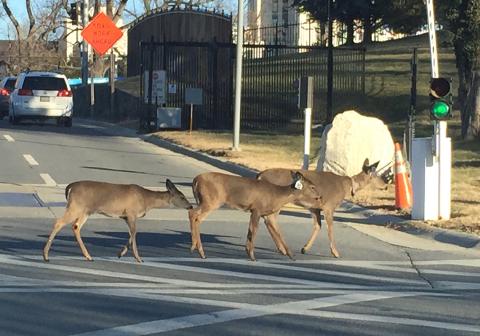Deer Survey Shows Herd Reaching Healthy Size

Many of us enjoy the presence of white-tailed deer roaming the grounds of the main campus, promoting a bucolic perspective in an otherwise urban landscape. Yet, in 2014, the deer population in our densely developed, enclosed campus was reaching a point that jeopardized their health and well-being, particularly due to nutritional deprivation. The herd had reached 45 deer on a 322-acre campus with a “livable square footage” able to sustain a herd of up to 26.
With no hunting permitted, no known predators, relocation outlawed and the increased threat of accidents and other human safety concerns rising during mating season, NIH decided to implement a long-term deer management program that included a humane, non-lethal stabilization of the population through anesthetization and spaying of adult females, as recommended by deer population control experts.
The deer management program is now in its third of 4 years. On the first weekend in December, a group of NIH volunteer veterinarians—the NIH wildlife veterinary volunteers—with the help of wildlife biologist consultants, conducted their annual deer survey on the Bethesda campus.
For the 2016 count, NIH has reached a healthy herd size with 24 deer—3 adult males, 1 male fawn, 1 untagged female fawn and 19 tagged females. In 2015, 29 deer were counted. With each year, NIH has approached a more favorable deer density, starting with 90 per square mile in 2014 to approximately half that density in 2016.
As a reminder, if you notice an injured or distressed wild animal on campus, call (301) 496-5685 or dial 311 from an NIH phone and an on-call veterinarian will be contacted to assist.
